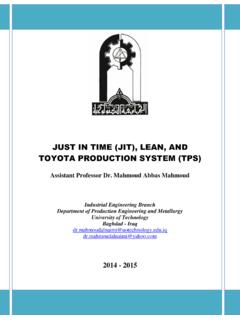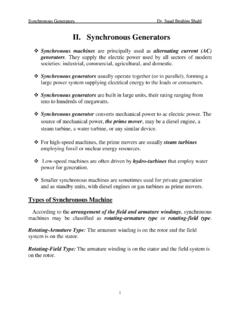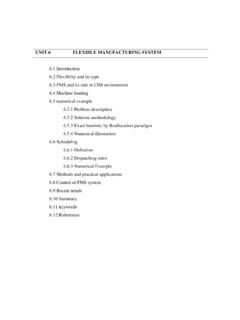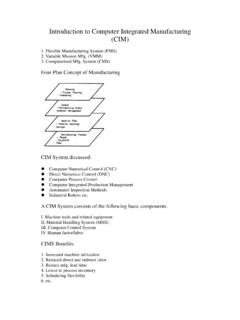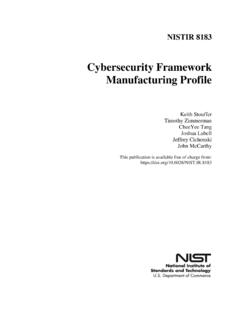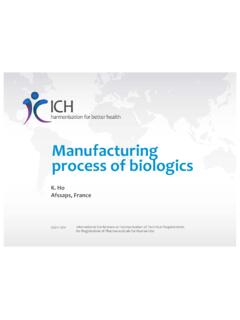Transcription of COMPUTER INTEGRATED MANUFACTURING
1 University of Technology CIM. Industrial Engineering Four Class COMPUTER INTEGRATED MANUFACTURING . 1. INTRODUCTION: COMPUTER INTEGRATED MANUFACTURING (CIM) encompasses the entire range of product development and MANUFACTURING activities with all the functions being carried out with the help of dedicated software packages. The data required for various functions are passed from one application software to another in a seamless manner. For example, the product data is created during design. This data has to be transferred from the modeling software to MANUFACTURING software without any loss of data.
2 CIM. uses a common database wherever feasible and communication technologies to integrate design, MANUFACTURING and associated business functions that combine the automated segments of a factory or a MANUFACTURING facility. CIM reduces the human component of MANUFACTURING and thereby relieves the process of its slow, expensive and error-prone component. CIM stands for a holistic and methodological approach to the activities of the MANUFACTURING enterprise in order to achieve vast improvement in its performance. MANUFACTURING engineers are required to achieve the following objectives to be competitive in a global context.
3 Reduction in inventory Lower the cost of the product Reduce waste Improve quality Increase flexibility in MANUFACTURING to achieve immediate and rapid response to: Product changes Production changes Process change Equipment change Change of personnel CIM technology is an enabling technology to meet the above challenges to the MANUFACTURING environment. Dr. Amjad Barazn Abdulghafour 1. University of Technology CIM. Industrial Engineering Four Class 2. EVOLUTION OF CIM: COMPUTER INTEGRATED MANUFACTURING (CIM) is considered a natural evolution of the technology of CAD/CAM which by itself evolved by the integration of CAD and CAM.
4 Massachusetts Institute of Technology (MIT, USA) is credited with pioneering the development in both CAD and CAM. If we review the MANUFACTURING scenario during 80's we will find that the MANUFACTURING is characterized by a few islands of automation. In the case of design, the task is well automated. In the case of manufacture, CNC machines, DNC systems, FMC, FMS etc provide tightly controlled automation systems. Similarly COMPUTER control has been implemented in several areas like MANUFACTURING resource planning, accounting, sales, marketing and purchase. Yet the full potential of computerization could not be obtained unless all the segments of MANUFACTURING are INTEGRATED , permitting the transfer of data across various functional modules.
5 This realization led to the concept of COMPUTER INTEGRATED MANUFACTURING . Thus the implementation of CIM required the development of whole lot of COMPUTER technologies related to hardware and software. 3. DEFINITION OF CIM: CIM is defined differently by different users, and can be implemented in varying an increasing degree of complexity. For many companies, improving shop- floor communications is the primary goal. Others extend the degree of integration to encompass communication between engineering and MANUFACTURING functions. The ultimate benefit of CIM is the improvement of communication and control of information flow to all aspects of an enterprise.
6 The COMPUTER and automated systems association of the society of MANUFACTURING Engineers (CASA/SEM) defines CIM is the integration of total MANUFACTURING enterprise by using INTEGRATED systems and data communication coupled with new managerial philosophies that improve organizational and personnel efficiency. CIM is recognized as Islands of Automation. They are 1. CAD/CAM/CAE/GT. 2. MANUFACTURING Planning and Control. 3. Factory Automation 4. General Business Management CASA/SME's CIM Wheel is as shown in figure 1. Dr. Amjad Barazn Abdulghafour 2. University of Technology CIM. Industrial Engineering Four Class Figure 1 CASA/SME's CIM Wheel 4.
7 CIM HARDWARE AND CIM SOFTWARE: CIM Hardware comprises the following: I. MANUFACTURING equipment such as CNC machines or computerized work centers, robotic work cells, DNC/FMS systems, work handling and tool handling devices, storage devices, sensors, shop floor data collection devices, inspection machines etc. II. Computers, controllers, CAD/CAM systems, workstations / terminals, data entry terminals, bar code readers, RFID tags, printers, plotters and other peripheral devices, modems, cables, connectors etc., CIM software comprises COMPUTER programs to carry out the following functions: Management Information system Job Tracking Sales Inventory Control Marketing Shop Floor Data Collection Finance Order Entry Database Management Materials Handling Modeling and Design Device Drivers Analysis Process Planning Simulation MANUFACTURING Facilities Planning Communications Work Flow Automation Dr.
8 Amjad Barazn Abdulghafour 3. University of Technology CIM. Industrial Engineering Four Class 5. ROLE OF THE ELEMENTS OF CIM system : Nine major elements of a CIM system are in Figure 2 they are, Marketing Product Design Planning Purchase MANUFACTURING Engineering Factory Automation Hardware Warehousing Logistics and Supply Chain Management Finance Information Management Figure 2 Major elements of CIM systems i. Marketing: The need for a product is identified by the marketing division. The specifications of the product, the projection of MANUFACTURING quantities and the strategy for marketing the product are also decided by the marketing department.
9 Marketing also works out the MANUFACTURING costs to assess the economic viability of the product. ii. Product Design: The design department of the company establishes the initial database for production of a proposed product. In a CIM system this is accomplished through activities such as geometric modeling and COMPUTER aided design while considering the product requirements and concepts generated by the creativity of the design engineer. Configuration management is an important activity in many designs. Complex designs are usually carried out by several teams working simultaneously, located often in different parts of the world.
10 The design process is constrained by the costs that will be incurred in actual production and by the capabilities of the available production equipment and processes. The design process creates the database required to manufacture the part. iii. Planning: The planning department takes the database established by the design department and enriches it with production data and information to produce a plan for the production of the product. Planning involves several subsystems dealing with materials, facility, process, tools, manpower, capacity, scheduling, outsourcing, assembly, inspection, logistics etc.
